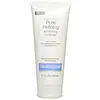Neutrogena Blackhead Eliminating Salicylic Acid Daily Face Scrub Versus Neutrogena Pore Refining Exfoliating Cleanser
What's inside
What's inside
 Key Ingredients
Key Ingredients

 Benefits
Benefits

 Concerns
Concerns

 Ingredients Side-by-side
Ingredients Side-by-side

Salicylic Acid 2%
MaskingWater
Skin ConditioningCetyl Alcohol
EmollientPPG-15 Stearyl Ether
EmollientPolyethylene
AbrasiveMethyl Gluceth-20
HumectantSteareth-21
CleansingCoco-Glucoside
CleansingSteareth-2
EmulsifyingPolysorbate 60
EmulsifyingLinoleamidopropyl Pg-Dimonium Chloride Phosphate
Neopentyl Glycol Dicaprylate/Dicaprate
EmollientMenthol
MaskingDisodium EDTA
Xanthan Gum
EmulsifyingPotassium Cetyl Phosphate
EmulsifyingAgar
MaskingMica
Cosmetic ColorantTitanium Dioxide
Cosmetic ColorantCI 77492
Cosmetic ColorantCI 15850
Cosmetic ColorantParfum
MaskingSalicylic Acid 2%, Water, Cetyl Alcohol, PPG-15 Stearyl Ether, Polyethylene, Methyl Gluceth-20, Steareth-21, Coco-Glucoside, Steareth-2, Polysorbate 60, Linoleamidopropyl Pg-Dimonium Chloride Phosphate, Neopentyl Glycol Dicaprylate/Dicaprate, Menthol, Disodium EDTA, Xanthan Gum, Potassium Cetyl Phosphate, Agar, Mica, Titanium Dioxide, CI 77492, CI 15850, Parfum
Water
Skin ConditioningDecyl Glucoside
CleansingCetyl Alcohol
EmollientGlycol Distearate
EmollientSodium Laureth-13 Carboxylate
CleansingCocamide Mea
EmulsifyingDisodium Lauryl Sulfosuccinate
CleansingPolyethylene
AbrasiveCocamidopropyl Betaine
CleansingSodium Methyl Cocoyl Taurate
CleansingSalicylic Acid
MaskingGlycolic Acid
BufferingPolyquaternium-11
Linoleamidopropyl Pg-Dimonium Chloride Phosphate
Sodium PCA
HumectantPEG-150 Pentaerythrityl Tetrastearate
EmulsifyingHydroxypropyl Guar
Emulsion StabilisingDisodium EDTA
BHT
AntioxidantParfum
MaskingWater, Decyl Glucoside, Cetyl Alcohol, Glycol Distearate, Sodium Laureth-13 Carboxylate, Cocamide Mea, Disodium Lauryl Sulfosuccinate, Polyethylene, Cocamidopropyl Betaine, Sodium Methyl Cocoyl Taurate, Salicylic Acid, Glycolic Acid, Polyquaternium-11, Linoleamidopropyl Pg-Dimonium Chloride Phosphate, Sodium PCA, PEG-150 Pentaerythrityl Tetrastearate, Hydroxypropyl Guar, Disodium EDTA, BHT, Parfum
Ingredients Explained
These ingredients are found in both products.
Ingredients higher up in an ingredient list are typically present in a larger amount.
Cetyl Alcohol is a fatty alcohol. Fatty Alcohols are most often used as an emollient or to thicken a product.
Its main roles are:
Though it has "alcohol" in the name, it is not related to denatured alcohol or ethyl alcohol.
The FDA allows products labeled "alcohol-free" to have fatty alcohols.
Learn more about Cetyl AlcoholDisodium EDTA plays a role in making products more stable by aiding other preservatives.
It is a chelating agent, meaning it neutralizes metal ions that may be found in a product.
Disodium EDTA is a salt of edetic acid and is found to be safe in cosmetic ingredients.
Learn more about Disodium EDTAWe don't have a description for Linoleamidopropyl Pg-Dimonium Chloride Phosphate yet.
Parfum is a catch-all term for an ingredient or more that is used to give a scent to products.
Also called "fragrance", this ingredient can be a blend of hundreds of chemicals or plant oils. This means every product with "fragrance" or "parfum" in the ingredients list is a different mixture.
For instance, Habanolide is a proprietary trade name for a specific aroma chemical. When used as a fragrance ingredient in cosmetics, most aroma chemicals fall under the broad labeling category of “FRAGRANCE” or “PARFUM” according to EU and US regulations.
The term 'parfum' or 'fragrance' is not regulated in many countries. In many cases, it is up to the brand to define this term.
For instance, many brands choose to label themselves as "fragrance-free" because they are not using synthetic fragrances. However, their products may still contain ingredients such as essential oils that are considered a fragrance by INCI standards.
One example is Calendula flower extract. Calendula is an essential oil that still imparts a scent or 'fragrance'.
Depending on the blend, the ingredients in the mixture can cause allergies and sensitivities on the skin. Some ingredients that are known EU allergens include linalool and citronellol.
Parfum can also be used to mask or cover an unpleasant scent.
The bottom line is: not all fragrances/parfum/ingredients are created equally. If you are worried about fragrances, we recommend taking a closer look at an ingredient. And of course, we always recommend speaking with a professional.
Learn more about ParfumPolyethylene is a synthetic ingredient that helps the skin retain moisture. It is a polymer.
It is also typically used within product formulations to help bind solid ingredients together and thicken oil-based ingredients. When added to balms and emulsions, it helps increase the melting point temperature.
Salicylic Acid (also known as beta hydroxy acid or BHA) is a well-known ingredient for treating skin that struggles with acne and clogged pores. It exfoliates both the skin's surface and deep within the pores to help clear out buildup, control oil, and reduce inflammation.
Unlike AHAs (alpha hydroxy acids), salicylic acid is oil-soluble. This allows it to penetrate into pores which makes it especially effective for treating blackheads and preventing future breakouts.
Salicylic acid is also known for its soothing properties. It has a similar structure to aspirin and can calm inflamed or irritated skin, making it a good option for acne-prone skin that is also sensitive.
Concentrations of 0.5-2% are recognized by the U.S. FDA as an over-the-counter topical acne product.
It can cause irritation and/or dryness if one's skin already has a compromised moisture barrier, so it's best to focus on repairing that before introducing this ingredient into your routine.
While salicylic acid does not increase sun sensitivity, it’s still important to wear sunscreen daily to protect your skin.
If you are looking for the ingredient called BHA or Butylated Hydroxyanisole, click here.
Learn more about Salicylic AcidWater. It's the most common cosmetic ingredient of all. You'll usually see it at the top of ingredient lists, meaning that it makes up the largest part of the product.
So why is it so popular? Water most often acts as a solvent - this means that it helps dissolve other ingredients into the formulation.
You'll also recognize water as that liquid we all need to stay alive. If you see this, drink a glass of water. Stay hydrated!
Learn more about Water